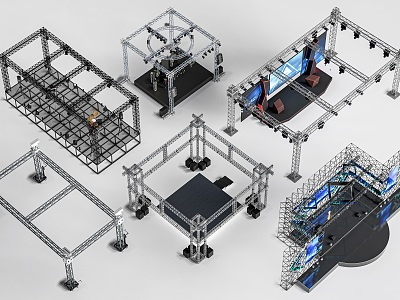In the evolving world of performance lighting, one of the greatest challenges designers face is lighting non-linear, organic-shaped stages. These stages—marked by flowing curves, asymmetrical forms, and immersive audience environments—require more than traditional 2D lighting techniques. 3D fixture mapping has emerged as a powerful solution to address these complexities, enabling precise control over fixture behavior across spatially dynamic environments.
Why Organic-Shaped Stages Are Difficult to Light
Traditional stage layouts—proscenium, thrust, or arena—offer predictable sightlines and fixture orientations. By contrast, organic-shaped stages are often:
Curvilinear or fractal-like in shape
Asymmetrical with multi-level performance zones
Surrounded by the audience (360° configuration)
Integrated into architecture or landscape features
Lighting these environments evenly and expressively is difficult due to angle dependencies, shadow inconsistencies, and fixture visibility limitations.

Limitations of 2D Fixture Mapping
Conventional lighting plans use 2D top-down CAD layouts. While effective for rectangular or circular rigs, they fall short when:
The stage has vertical curvature (e.g., ramps, waveforms)
Lighting effects need to follow performer movement across height changes
Obstructions (columns, sculptures) affect beam spread
This results in misaligned beams, unexpected spill, or overexposed zones—especially when programming dynamic shows.
What is 3D Fixture Mapping?
3D fixture mapping involves placing lighting fixtures into a spatially accurate 3D model of the stage and venue, allowing designers to:
Simulate beam spread, falloff, and color rendering from multiple angles
Program lighting cues based on volumetric space, not just coordinates
Minimize shadow conflicts and over-illumination
Visualize audience sightlines from every seat
This approach is indispensable for performances using motion capture, interactive projection, or immersive choreography.
Key Technologies Enabling 3D Mapping
To implement effective 3D fixture mapping, several technical tools are essential:
3D Stage Modeling Software
Tools like Vectorworks Spotlight, Capture, or WYSIWYG allow accurate venue modeling, fixture placement, and light visualization.Protocol Support
Control systems must be compatible with ArtNet, sACN, or MA-Net to maintain real-time DMX addressing across mapped environments.Addressable Fixtures with Pan/Tilt Feedback
Intelligent lights with internal sensors allow position-aware programming inside a 3D grid.Real-Time Preview Engines
Simulators render photorealistic previews of lighting effects on complex geometries, helping pre-visualize effects.
Step-by-Step: Implementing 3D Mapping on Organic Stages
Scan or Model the Venue
Use LIDAR scanning or manual modeling to capture curves, contours, and obstacles.
Fixture Placement in 3D Space
Use true-to-scale fixture models with accurate beam angles and lens types.
Assign DMX Addresses and Logical Groups
Organize fixtures not by position but by their intended role in spatial coverage.
Run Pre-Visualization Simulations
Evaluate how light interacts with stage geometry and audience sightlines.
Adjust Based on Rehearsals
Make final tweaks on site, including modifying pan/tilt limits or remapping cues.
Key Considerations
| Factor | Recommendation |
|---|---|
| Beam Angle | Narrow beams may miss curved zones |
| Lens Choice | Zoomable optics offer better adaptability |
| Mounting Height | Vary positions to reduce overconcentration |
| Control Channel Load | Use node-based mapping for complex matrices |
| Programming Time | Expect longer timelines vs. traditional shows |
Real-World Applications
3D mapping is being adopted in a variety of performance formats:
Immersive Theater: Lighting follows performers in dynamic, multi-angle choreography (e.g., Sleep No More)
Environmental Shows: Projection and lights blend in domes or caves
Experimental Dance: Organic stages paired with reactive lighting respond to body movement
Theme Parks: Organic landscape structures are lit consistently without traditional truss rigs
Challenges and Limitations
While powerful, 3D mapping introduces its own complexity:
Hardware compatibility: Not all fixtures support position tracking or high-resolution pan/tilt
Data load: Real-time rendering can overload consoles or media servers
Calibration drift: Physical setups must match digital models exactly
Budget/time: Modeling and programming often require specialized teams
Yet, as demand for immersive and flexible stages grows, these challenges are being addressed with improved tools and training.
The Future: AI and Automation in Mapping
Emerging tools are applying AI-driven scene analysis to automate mapping and cue generation based on show scripts, music dynamics, and performer motion capture.
As this technology evolves, expect:
Faster preproduction workflows
Autocorrect for beam overlap and spill
Integration with motion-tracking wearables
Dynamic mapping that adjusts in real time
Conclusion
3D fixture mapping is a game-changing advancement in stage lighting design. It allows lighting professionals to transcend the limitations of flat layouts and illuminate complex architectural or organic spaces with precision and artistry.
For productions seeking depth, dimensionality, and dynamic flow, embracing 3D mapping unlocks a new world of visual possibilities.
READ MORE:





Blue Sea Lighting is an enterprise with rich experience in the integration of industry and trade in stage lighting and stage special effects related equipment. Its products include moving head lights, par lights, wall washer lights, logo gobo projector lights, power distributor, stage effects such as electronic fireworks machines, snow machines, smoke bubble machines, and related accessories such as light clamps.
Quick Links
For more questions subscribe to our email








